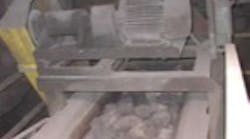A typical application is this Planetgear speed reducer atop an inclined charging conveyor that delivers coke, limestone, silicon carbide, and other alloying materials to the foundry's plasma melter.
The GM Powertrain foundry in Defiance, OH, had an ongoing problem: replacing obsolete, hard-to-repair speed reducers.
The operation is one of the world's largest gray iron foundries, producing engine block and head castings for various GM vehicles. Its 120 tons/hour cupola furnace also ranks as one of the largest in the world.
Replacing parts for the speed reducers used on hundreds of drives for conveyor and elevator at Defiance required large-scale rebuilding efforts. In some cases, the reducers failed nearly every six months.
This problem was accentuated by fact that the speed reducers had become difficult to source: They had been supplied with the original equipment, installed many years ago.
"The manufacturer made everything themselves, so we couldn't just replace the gearbox," explains maintenance supervisor Jim Gary. "We had to buy the parts and physically build the replacement in place. In many cases, we had to change the highspeed shaft and bearings every 6-10 months, and the entire gearbox every 2-4 years."
To eliminate these problems, and keep downtime to a minimum, GM Powertrain Defiance started a long-term program to replace the original gearboxes with Rex Planetgear (www.rexnord.com) drives. In these reducers, self-aligning planet carriers float radially and axially to provide perfect alignment of the geartrain. While traditional gears have only one point of contact per reduction, the new reducers transmit torque through three points of contract, between the sun gears and planet gears. The floating gear train ensures equal loading among the three points. Two seals on both the input and output shafts help prevent bearing contamination in the foundry's gritty environment.
Most of the reducers were replaced in small batches at pre-planned times. "We knew the old drives were obsolete, so we anticipated which ones we needed to change out next and ordered the Planetgears ahead of time," notes Gary. The No. 3 Plasma Melter was an exception, as the new style reducers were installed along with other new equipment.
Gary explains that GM Powertrain has approximately 600 of the new reducers in place now, with more still to be converted. Sizes range from the Mercury, Mars, and Saturn series up to Titan series on large furnace drives. One loaded furnace, weighing about 350 tons, is driven by a 20-hp motor through a Planetgear with a 532:1 ratio. Motors on smaller equipment range from 2 to 15 hp, with most falling in the range of 5 to 10 hp. Even with such a wide range of applications, Gary has standardized whenever possible to minimize the number of different reducers and reduce parts inventories. "Some of the furnaces are smaller than others, but we still will use the same size on all so we have five furnaces with the same reducer," he says.
He points out that Planetgears are a lot easier to install. "We don't have to shim the bearings or do a lot of other things we had to do with the old drives. It's easier to change ratios when we need to. Before we had to change sprockets to change the speed, and then sometimes the motor wasn't big enough and had to be changed."
Many of the reducers are connected to the motors through Rex Omega couplings. These split-in-half flexible polyurethane couplings consist of only four components: two hubs and two half elements. They are designed for easy maintenance, and the flex element can be replaced easily without disturbing the hubs or moving and realigning connected equipment. The polyurethane-to-metal flex element bond design and radial bolting makes assembly and disassembly very quick and efficient.
"They're a really easy unit to change, and they can stand more misalignment than the pin-and-bushing couplings we had, without wearing," states Gary. "We have them in high-heat areas and everywhere else, and they are very durable. We haven't had any failures due to the environment."
On skip-hoist drives and other applications where heavy loads and safety concerns are involved, the couplings include an optional positive drive feature that incorporates an interlocking drive to provide overload protection. Two jaw assemblies bolted inside the coupling hubs have protrusions 180° apart. When the coupling is installed, the two sides are offset to provide a protrusion every 90° . During normal operation, the jaws do not contact each other, and the coupling functions normally. If an extreme overload failure occurs and the coupling element is compromised, the drive side jaws will contact the driven side jaws and continue to transmit torque to maintain control of the load.
The first of many such applications at Defiance was installed on a coke charge car in 1996. The skip hoist, driven by a 100-hp motor at 47 rpm, pulls a car loaded with coke and weighing more than 10,000 lb to charge a cupola furnace. A reel drive consisting of a motor, gearbox, and 30-in. diameter drum pulls the car about 45 ft. up a 60° incline. An Omega E140 positive-drive coupling between the gearbox and reel transmits the torque to the reel and prevents the possibility of the heavy car "ghost riding" to the bottom if the coupling were to fail. In that case, the interlocking jaws would continue to hold the load.










